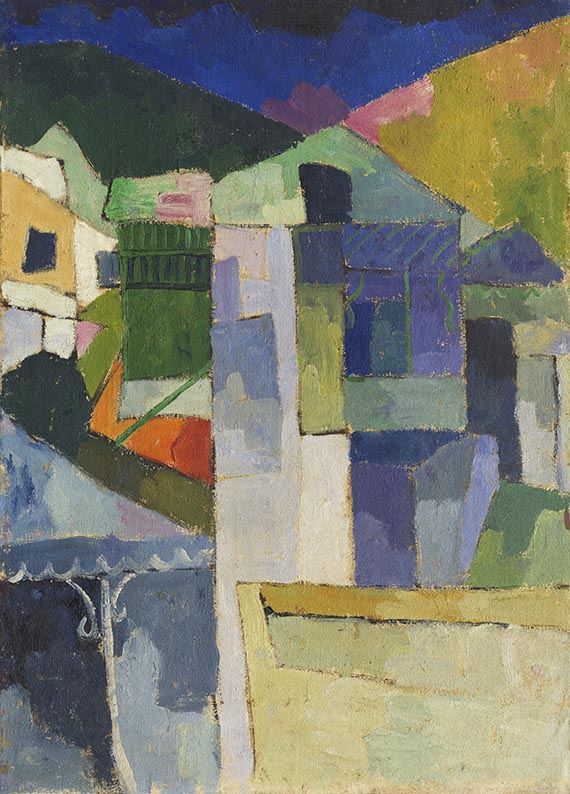Dictionary


Kronberger Art Colony
The Kronberg painters' colony was located in the small town of Kronberg in the Taunus mountains and was founded by Jakob Fürchtegott Dielmann (1809-85) in 1858, he had already been active in the colony in Willingshausen. Another founding member was Anton Burger (1824-1905), both were soon joined by their friends Philipp Rumpf, Jacob Maurer, Angilbert Göbel and Karl Schäffer.
The group discussed issues of art and created rural scenes, often in front of landscapes in the background. Together they worked en plein air and lived, permanent or on and off in the inn "Gasthof zum Adler".
The painters of the Kronberg colony did not remain unimpressed by the French innovations: Peter Burnitz (1824-86), who had lived in France for some time and was geared to the School of Barbizon, introduced French Pleinairism and the genre of "paysage intime" to Kronberg. The realist achievements of Barbizon would only slowly took a hold in Kronberg, especially as genre scenes and vedutas were more popular with the audience. An artistic path that gradually followed the French model, was laid by Peter Burnitz, but also by other artists, such as Adolf Schreyer, Norbert Schrödl, Friedrich Steinhardt, Heinrich Winter, Otto Scholderer, Victor Müller and Louis Eysen.
The circle of Kronberg artists grew in the 1870s, a large part of them cam efrom the nearby Frankfurt. Most of them, more than 20, among them quite a number of women - were educated by Anton Burger; the others had mostly been studying at the art school of the Frankfurt Städelsche Institut, where Jakob Becker was the then most influential figure. Unlike him, Anton Burger had a rather critical attitude towards academic studio painting and additionally tried to familiarize his students in Kronberg with Dutch Baroque, particularly in form of landscape and genre. Among Burger's most important students were Philipp Franck (1860-1944), Nelson Kinsley (1863-1945) and Fritz Wucherer (1873-1948).
The Kronberg colony began to break up gradually around the turn of the century. Relevant members had left Kronberg or were dead, so that the strong company of previous days was not in existence any longer. The death of Anton Burgers in 1905 marked the end of the Kronberg painters' colony for good.
The Kronberg painters' colony was located in the small town of Kronberg in the Taunus mountains and was founded by Jakob Fürchtegott Dielmann (1809-85) in 1858, he had already been active in the colony in Willingshausen. Another founding member was Anton Burger (1824-1905), both were soon joined by their friends Philipp Rumpf, Jacob Maurer, Angilbert Göbel and Karl Schäffer.
The group discussed issues of art and created rural scenes, often in front of landscapes in the background. Together they worked en plein air and lived, permanent or on and off in the inn "Gasthof zum Adler".
The painters of the Kronberg colony did not remain unimpressed by the French innovations: Peter Burnitz (1824-86), who had lived in France for some time and was geared to the School of Barbizon, introduced French Pleinairism and the genre of "paysage intime" to Kronberg. The realist achievements of Barbizon would only slowly took a hold in Kronberg, especially as genre scenes and vedutas were more popular with the audience. An artistic path that gradually followed the French model, was laid by Peter Burnitz, but also by other artists, such as Adolf Schreyer, Norbert Schrödl, Friedrich Steinhardt, Heinrich Winter, Otto Scholderer, Victor Müller and Louis Eysen.
The circle of Kronberg artists grew in the 1870s, a large part of them cam efrom the nearby Frankfurt. Most of them, more than 20, among them quite a number of women - were educated by Anton Burger; the others had mostly been studying at the art school of the Frankfurt Städelsche Institut, where Jakob Becker was the then most influential figure. Unlike him, Anton Burger had a rather critical attitude towards academic studio painting and additionally tried to familiarize his students in Kronberg with Dutch Baroque, particularly in form of landscape and genre. Among Burger's most important students were Philipp Franck (1860-1944), Nelson Kinsley (1863-1945) and Fritz Wucherer (1873-1948).
The Kronberg colony began to break up gradually around the turn of the century. Relevant members had left Kronberg or were dead, so that the strong company of previous days was not in existence any longer. The death of Anton Burgers in 1905 marked the end of the Kronberg painters' colony for good.
Offers
Headquarters
Joseph-Wild-Str. 18
81829 Munich
Phone: +49 89 55 244-0
Fax: +49 89 55 244-177
info@kettererkunst.de
Louisa von Saucken / Undine Schleifer
Holstenwall 5
20355 Hamburg
Phone: +49 40 37 49 61-0
Fax: +49 40 37 49 61-66
infohamburg@kettererkunst.de
Dr. Simone Wiechers / Nane Schlage
Fasanenstr. 70
10719 Berlin
Phone: +49 30 88 67 53-63
Fax: +49 30 88 67 56-43
infoberlin@kettererkunst.de
Cordula Lichtenberg
Gertrudenstraße 24-28
50667 Cologne
Phone: +49 221 510 908-15
infokoeln@kettererkunst.de
Hessen
Rhineland-Palatinate
Miriam Heß
Phone: +49 62 21 58 80-038
Fax: +49 62 21 58 80-595
infoheidelberg@kettererkunst.de
We will inform you in time.




